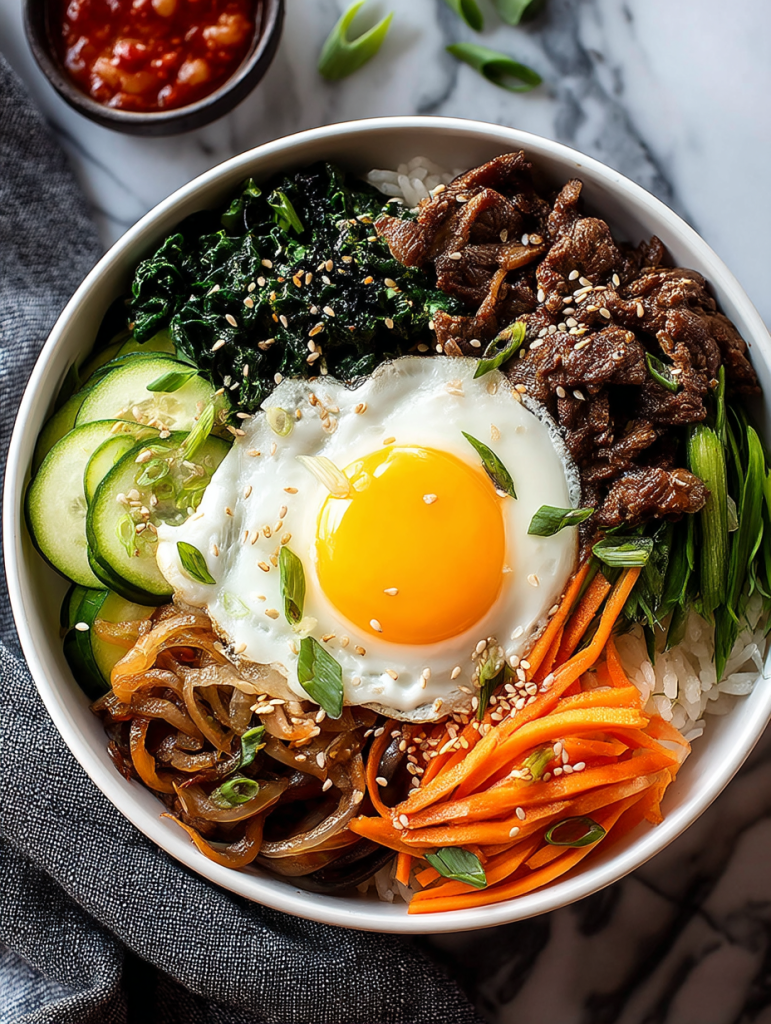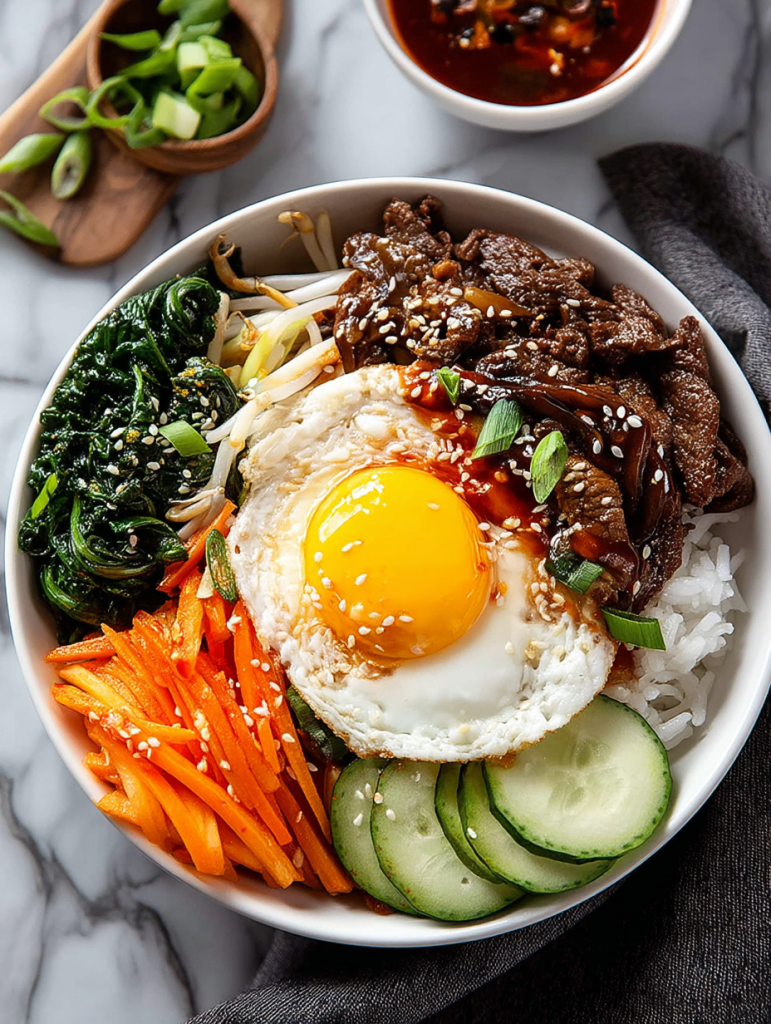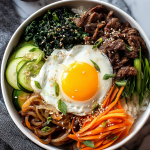Colorful, bold, and endlessly customizable, Easy Korean Bibimbap is the kind of dish that turns everyday ingredients into something truly spectacular. Bibimbap means “mixed rice” in Korean, and that’s exactly what it delivers: a warm bowl of fluffy rice topped with a vibrant mix of sautéed vegetables, tender marinated beef, and a perfectly fried egg, all brought together with a spicy-sweet gochujang sauce.


What makes bibimbap truly exciting is how it balances textures and flavors. The crispy edges of the rice, the creamy richness of the egg yolk, the crunch of fresh vegetables, and the kick of fermented chili paste make every bite a mini explosion. Whether you’re diving in with chopsticks or mixing it all with a spoon, this meal feels satisfying in every sense.
Why You’ll Love This Easy Korean Bibimbap
This dish is a dream for weeknight dinners or impressive weekend meals. It’s healthy, hearty, and lets you use up leftover vegetables or proteins. With just a bit of prep and layering, you get a gorgeous, restaurant-style bowl that everyone can customize to their own tastes. It’s also naturally gluten-free (if using the right gochujang) and endlessly adaptable—swap in tofu or mushrooms for a vegetarian version!
What Kind of Rice Should I Use?
Short-grain white rice (like sushi rice) is the most traditional option and gives bibimbap its signature chewy texture. But jasmine or even brown rice can work if that’s what you have. If you want to be extra authentic, try dolsot bibimbap, where the rice crisps up in a hot stone bowl—it’s unbeatable for texture lovers!
Ingredients for the Easy Korean Bibimbap
Each component in this bowl plays a special role in building both flavor and presentation. Here’s what you’ll need:
- Cooked white rice: The base of the bowl, providing warmth and comfort.
- Marinated beef (like bulgogi): Adds savory-sweet richness; you can also sub with tofu or mushrooms.
- Carrots (julienned): Offer a sweet crunch and vibrant color.
- Spinach: Sautéed lightly, it brings a tender, earthy contrast.
- Bean sprouts: Add a refreshing, slightly nutty crispness.
- Cucumber or zucchini: For a fresh bite and light texture.
- Fried egg: The runny yolk turns into a creamy sauce when mixed.
- Gochujang sauce: Spicy, tangy, and a little sweet—the bold flavor glue of the dish.
- Sesame oil & sesame seeds: Finish with aroma and a nutty crunch.
How To Make the Easy Korean Bibimbap
Step 1: Cook the Rice
Prepare 2 cups of short-grain rice according to package instructions. Fluff it with a fork and keep warm.
Step 2: Prep and Cook the Vegetables
Sauté spinach, bean sprouts, julienned carrots, and zucchini separately with a touch of sesame oil and salt. This keeps each veggie’s flavor distinct and fresh.
Step 3: Cook the Beef
Marinate sliced beef in a bulgogi-style sauce (soy sauce, sugar, garlic, sesame oil) for at least 20 minutes. Stir-fry over medium-high heat until nicely browned.
Step 4: Fry the Egg
Fry eggs sunny-side up so the yolk remains runny. This adds richness to the final mix.
Step 5: Assemble the Bowl
Scoop rice into bowls, arrange vegetables and beef on top in sections, then place the egg in the center. Drizzle with gochujang sauce and a touch of sesame oil. Sprinkle with sesame seeds.

How to Serve and Store Bibimbap
This recipe feeds 4 hungry people or 6 if served with sides. To serve, encourage everyone to mix their bowls thoroughly before eating—that’s the fun part! If you want to go traditional, use stone bowls to crisp the rice bottom.
Leftovers can be stored in the fridge for up to 3 days. Store components separately if possible, and reheat gently to keep textures intact.
What to Serve With Bibimbap?
Korean Kimchi
Its tangy, fermented heat cuts through the richness of the bowl.
Miso Soup
A light, warming starter to balance the meal.
Pickled Radish
Sweet, sour, and crunchy—perfect to refresh your palate.
Korean Seaweed Salad
A cool, umami-rich contrast that adds more green goodness.
Steamed Dumplings
Soft and savory, they pair wonderfully with the bold bibimbap flavors.
Scallion Pancakes
Crispy and savory, ideal as an appetizer or side.
Cucumber Salad
Refreshing and quick to prepare, with a cooling effect against the heat of gochujang.
Green Tea
Cleansing and traditional, perfect to sip between bites.
Want More Rice Bowl Ideas?
If you love the balanced beauty of this Korean Bibimbap, you might enjoy these creative bowl meals:
- Cheesy Zucchini Casserole for a rich, comforting veggie-forward bake.
- Garlic Butter Shrimp Scampi Lasagna when you’re craving seafood with a twist.
- Avocado Egg and Chickpea Salad for a no-rice, protein-packed alternative.
- Taco Ranch Bites for a Tex-Mex spin on bold, bite-sized flavors.
- Easy Veggie Patties if you want to turn your rice bowl into a crispy, handheld treat.
Save This Pin For Later
📌 Save this recipe to your Pinterest dinner board so you can revisit it anytime.
Did you try yours with beef, tofu, or mushrooms? Let me know in the comments how you made it your own. Questions are welcome too—let’s make every bowl better together.
Explore more stunning, feel-good dishes on NoraNosh Recipes on Pinterest and find your next favorite bowl or bake!
Print
Easy Korean Bibimbap
- Total Time: 40 minutes
- Yield: 4 servings
Description
Get ready for a colorful, flavor-packed dinner with this Easy Korean Bibimbap! It’s a hearty rice bowl layered with savory marinated beef, sautéed veggies, a runny fried egg, and spicy gochujang sauce. This easy recipe brings bold Korean flavors to your kitchen using everyday ingredients. Perfect for a healthy snack, quick lunch, or satisfying weeknight dinner, Bibimbap is also customizable and great for using up leftovers. Whether you’re looking for new food ideas, breakfast ideas with a twist, or easy dinner ideas that impress, this balanced and nourishing dish checks all the boxes.
Ingredients
2 cups cooked white rice
1 cup marinated beef (bulgogi style)
1 cup julienned carrots
1 cup sautéed spinach
1 cup bean sprouts
1 small cucumber, thinly sliced
4 eggs
4 tablespoons gochujang sauce
2 teaspoons sesame oil
1 teaspoon sesame seeds
Instructions
1. Cook the rice according to package instructions and keep warm.
2. Sauté spinach, carrots, bean sprouts, and cucumber separately in sesame oil with a pinch of salt.
3. Marinate beef slices in soy sauce, garlic, sugar, and sesame oil. Stir-fry until browned.
4. Fry the eggs sunny-side up with runny yolks.
5. Assemble bowls by adding rice, placing vegetables and beef in sections, and topping with an egg.
6. Drizzle gochujang and sesame oil over everything.
7. Sprinkle with sesame seeds and serve hot.
Notes
For a vegetarian version, substitute tofu or mushrooms for the beef.
If using a stone bowl (dolsot), preheat it to get a crispy rice base.
- Prep Time: 25 minutes
- Cook Time: 15 minutes
- Category: Main Dish
- Method: Stir-Fry
- Cuisine: Korean
Nutrition
- Serving Size: 1 bowl
- Calories: 480
- Sugar: 6g
- Sodium: 720mg
- Fat: 18g
- Saturated Fat: 5g
- Unsaturated Fat: 11g
- Trans Fat: 0g
- Carbohydrates: 54g
- Fiber: 4g
- Protein: 22g
- Cholesterol: 195mg
Keywords: Korean recipes, bibimbap, rice bowl, easy recipe, dinner ideas, beef bowl

